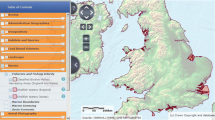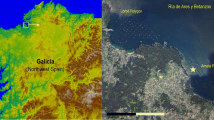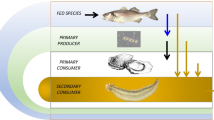Abstract
Oncorhynchus kisutch, O. mykiss and Gracilaria chilensis cultivation in intensive tank systems is feasible. The environmental benefits associated with the development of integrated tank cultivation were established by analyzing previously published and unpublished data on fish production and food conversion efficiency, particle discharges in fish effluents, as well as biomass production, nutrient uptake efficiency data of Gracilaria, with special emphasis on ammonium. The results indicate that fish production can reach 30 kg m−3 during a production cycle, and food conversion can be maintained stably at 1.4 g food g fish−1 production during the entire cultivation period. The solid particle discharges can be as high as 2.1 g (dry) kg fish−1 day−1 during the spring and summer, when salmon cultivation reaches its highest densities. The nutrient that increases most in fish effluents is ammonium, reaching concentrations as high as 500 µg 1−1, also in spring and summer. Gracilaria production can reach production rates as high as 48.9 kg m−2 year−1 and is able to remove 50% of the dissolved ammonium in winter, increasing to 90–95% in spring. These results are integrated into an income-analysis model, adding the extra income for Gracilaria harvesting and internalizing the environmental benefits for a 100-ton salmon production unit, which indicates that an additional total revenue of over US$ 60 000, representing around 10% of the total income, is possible.
Similar content being viewed by others
References
Anonymous, 1994. Anuario Estaístico de Pesca 1993. Servicio, Nacional de Pesca, Valparaíso, 190 pp.
Aspila, K. I., H. Agemian & A. S. Y. Chau, 1976. A semi-automated method for the determination of inorganic and total phosphate in sediments. Analyst 101: 187–197.
Avila, M. & M. Seguel, 1993. An overview of seaweed resources in Chile. J. appl. Phycol. 5: 133–139.
Beveridge, M. C. M., 1984. Cage and pen fish farming. Carrying capacity models and environmental impacts. FAO Fish Tech. Pap. 255: 1–133.
Bidwell, R. G. S., J. McLachlan & N. D. Lloyd, 1985. Tank cultivation of Irish moss, Chondrus crispus Stackh. Bot, mar. 28: 87–97.
Boeuf, G., H. Kossmann & A. Medina, 1992. Le développement de la salmoniculture au Chile en 1992. La Pisciculture Francaise 109: 5–29.
Buschmann, A. H., D. A. López & A. Medina, 1993. Costos y tecnologías para minimizar el impacto ambiental. Ambiente y Desarrollo 9: 71–75.
Buschmann, A. H., R. Westermeier & C. A. Retamales, 1995. Cultivation of Gracilaria in the seabottom in southern Chile: a review. J. appl. Phycol. 7: 291–301.
Buschmann, A. H., O. A. Mora, P. Gómez, M. Böttger, S. Buitano, C. Retamales, P. A. Vergara & A. Gutierrez, 1994. Gracilaria chilensis outdoor tank cultivation in Chile: use of land-based salmon culture effluents. Aquacult. Engin. 13: 283–300.
Carlsson, P. & E. Granéli, 1993. Availability of humic bound nitrogen for coastal phytoplankton. Estuar., coast. Shelf Sci. 36: 433–447.
Cohen, I. & A. Neon, 1991. Ulva lactuca biofilters for marine fishponds effluents. Bot. mar. 34: 475–482.
Colt, J. & B. Watten, 1988. Applications of pure oxygen in fish culture. Aquacult. Engin. 7: 397–441.
Edvardsen, B., F. Moy & E. Paasche, 1990. Hemolytic activity extracts of Chrysochromulina polylepis grown at different levels of selenite and phosphate. In E. Granéli, B. Sundström, E. Edler & D. Andersson (eds), Toxic Marine Phytoplankton. Elsevier, New York: 284–289.
Enell, M., 1987. Environmental impact of cage fish farming with special reference to phosphorus and nitrogen loadings. Comm. Meet Int. Conn. Explor. Sea, C.M.-ICES/F44, Ref. MEQC.
Fivelstad, S., 1988. Waterflow requirements for salmonids in singlepass and semi-closed land-based seawater and freshwater systems. Aquacult. Engin. 7: 183–200.
Folke, C. & N. Kautsky, 1988. The role of ecosystems for a sustainable development of aquaculture. Ambio 18: 234–243.
Folke, C. & N. Kautsky, 1992. Aquaculture with its environment: prospects for sustainability. Ocean coast. Mgmt. 17: 5–24.
Folke, C., N. Kautsky & M. Troell, 1994. The cost of eutrophication from salmon farming: implications for policy. J. envir. Mgmt. 40: 173–182.
Gowen, R. J. & N. B. Bradbury, 1987. The ecological impact of salmonid farming in coastal waters: a review. Oceanogr. mar. Biol. Annu. Rev. 25: 563–575.
Gowen, R. J., D. P. Weston & A. Ervik, 1991. Aquaculture and the benthic environment. In C. B. Cowey and C. Y. Cho (eds), Nutritional Strategies and Aquaculture Waste. University of Guelph, Ontario.
Granéli, E., P. Carlsson, P. Olsson, B. Sundström, W. Granéli & O. Lindahl, 1989. From anoxia to fish poisoning: the last ten years of phytoplankton blooms in Swedish marine waters. In E. M. Cosper, V. M. Bricelj & E. J. Carpenter (eds), Novel Phytoplankton Blooms-Causes and Impacts of Recurrent Brown Tides and Other Unusual Blooms. Springer Verlag, New York: 407–428.
Haglund, K. & M. Pedersén, 1993. Outdoor pond cultivation on the subtropical marine red alga Gracilaria tenuistipitata in brackish water in Sweden. Growth, nutrient uptake, co-cultivation with rainbow trout and epiphyte control. J. appl. Phycol. 5: 271–284.
Hall, P. O. J., L. G. Andersson, O. Holby, S. Kollberg & M.-O. Samulesson, 1990. Chemical fluxes and mass balances in a marines fish cage farm. I. Carbon. Mar. Ecol. Prog. Ser. 61: 61–73.
Hall, P. O. J., O. Holby, S. Kollberg & O.-M. Samuelsson, 1992. Chemical fluxes and mass balances in a marines fish cage farm IV. Nitrogen. Mar. Ecol. Prog. Ser. 89: 81–91.
Handy, R. D. & M. G. Poxton, 1993. Nitrogen pollution in mariculture: toxicity and excretion of nitrogenous componds by marine fish. Rev. Fish Biol. Fish. 3: 205–241.
Harlin, M. M., B. Thorne-Miller & B. G. Thursby, 1979. Ammonium uptake by Gracilaria sp. (Florideophyceae) and Ulva lactuca (Chlorophyceae) in closed system fish culture. In A. Jensen & J. R. Stein (eds), Proc. IXth Int. Seaweed Symp. Science Press, Princeton, NJ: 285–293.
Holby, O. & P. O. J. Hall, 1991. Chemical fluxes and mass balances in a marine cage farm. II. Phosphorus. Mar. Ecol. Prog. Ser. 70: 263–272.
López, D. A., A. H. Buschmann & M. L. González, 1988. Efectos del use de las zonas costeras por prácticas de acuicultura. Medio Ambiente 9: 42–54.
Martinez, L. A., 1994. Uso de efluentes de salmonfdeos para el cultivo de Gracilaria chilensis en estanques: Rendimineto y calidad de agar. Thesis, Universidad de Los Lagos, Osomo, Chile, 80 pp.
Medina, A., N. Pardo, C. O. Vargas, J. C. Uribe & A. H. Buschmann, 1993. Un estudio comparativo del cultivo de Oncorhynchus kisutch W. en estanques costeros y balsas jaulas en el sur de Chile. Rev. Biol. Mar., Valparaíso 28: 247–259.
Neori, A., I. Cohen & H. Gordin, 1991. Ulva lactuca biofilters for marine fish-pond effluents. II. Growth rate, yield and C:N ratio. Bot. mar. 34: 483–489.
Penczak, T., W. Galicka, M. Molinski, E. Kusto & M. Zalewski, 1982. The enrichment of a mesotrophic lake by carbon, phosphorus and nitrogen from cage aquaculture of rainbow trout, Salmo gairdneri. J. appl. Ecol. 19: 371–393.
Persson, G., 1986. Kasseodling av regnbåge; Närsaltsemissoner och miljö vid tre odlinslägen längst smålamdskusten. Rapport 3215. Nat. Swed. Envir. Prot. Bd., Solna: 1–42.
Phillips, M. J., M. C. M. Beveridge & J. F. Muir, 1986. Waste output and environmental effects of rainbow trout cage culture. Comm. meet. Int. Count. Explor. Sea, C.M.-ICES/F:21, Maricult. Comm., Sess W 18 pp.
Rosenthal, H., D. Weston, R. Gowen & E. Black, 1988. Report of the ad-hoc study group on "Environmental impact of mariculture". Cooperative Research, Report No. 154, 83 pp.
Shpigel, M. & R. A. Blaylock, 1991. The Pacific oyster, Crassostrea gigas, as a biological filter for a marine fish aquaculture pond. Aquaculture 92: 187–197.
Seymour, E. A. & A. Bergheim, 1991. Towards a reduction of pollution from intensive aquaculture with reference to the farming of salmonids in Norway. Aquacult. Engin. 10: 73–88.
Solorzano, L., 1969. Determination of ammonia in waters by the phenolhydrochlorite method. Limnol. Oceanogr. 14: 799–801.
Strickland, J. D. H. & T. R. Parsons, 1972. A practical handbook of seawater analysis. Fish. Res. Bd. Can. Bull. 167: 1–310.
Ugarte, R. & B. Santelices, 1992. Experimental tank cultivation of Gracilaria chilensis in central Chile. Aquaculture 101: 7–16.
Vandermeulen, H. & H. Gordin, 1990. Ammonium uptake using Ulva (Chlorophyta) in intensive fishpond systems: mass culture and treatment of effluent. J. appl. Phycol. 2: 363–374.
Author information
Authors and Affiliations
Rights and permissions
About this article
Cite this article
Buschmann, A.H., Troell, M., Kautsky, N. et al. Integrated tank cultivation of salmonids and Gracilaria chilensis (Gracilariales, Rhodophyta). Hydrobiologia 326, 75–82 (1996). https://doi.org/10.1007/BF00047789
Issue Date:
DOI: https://doi.org/10.1007/BF00047789




